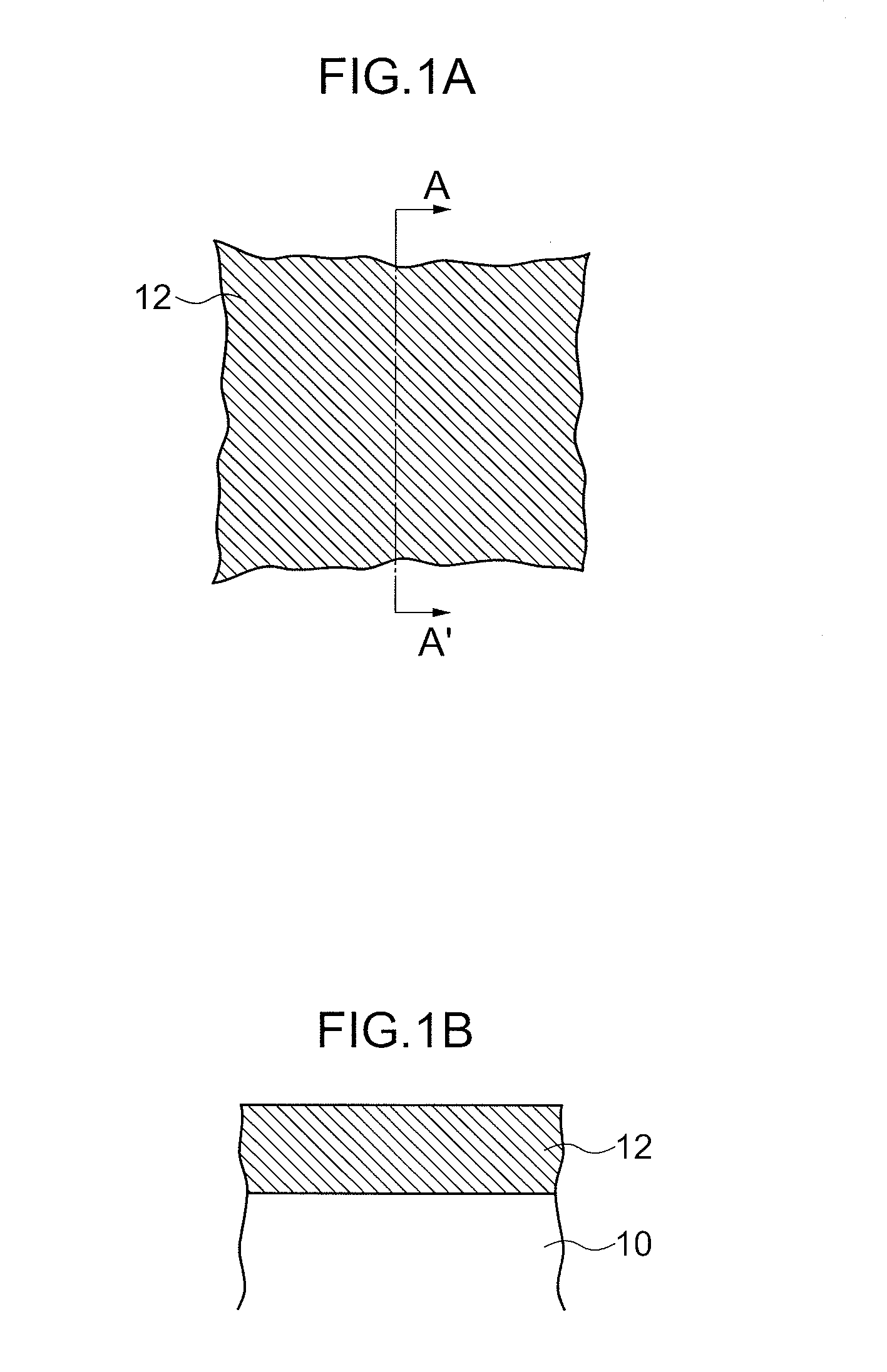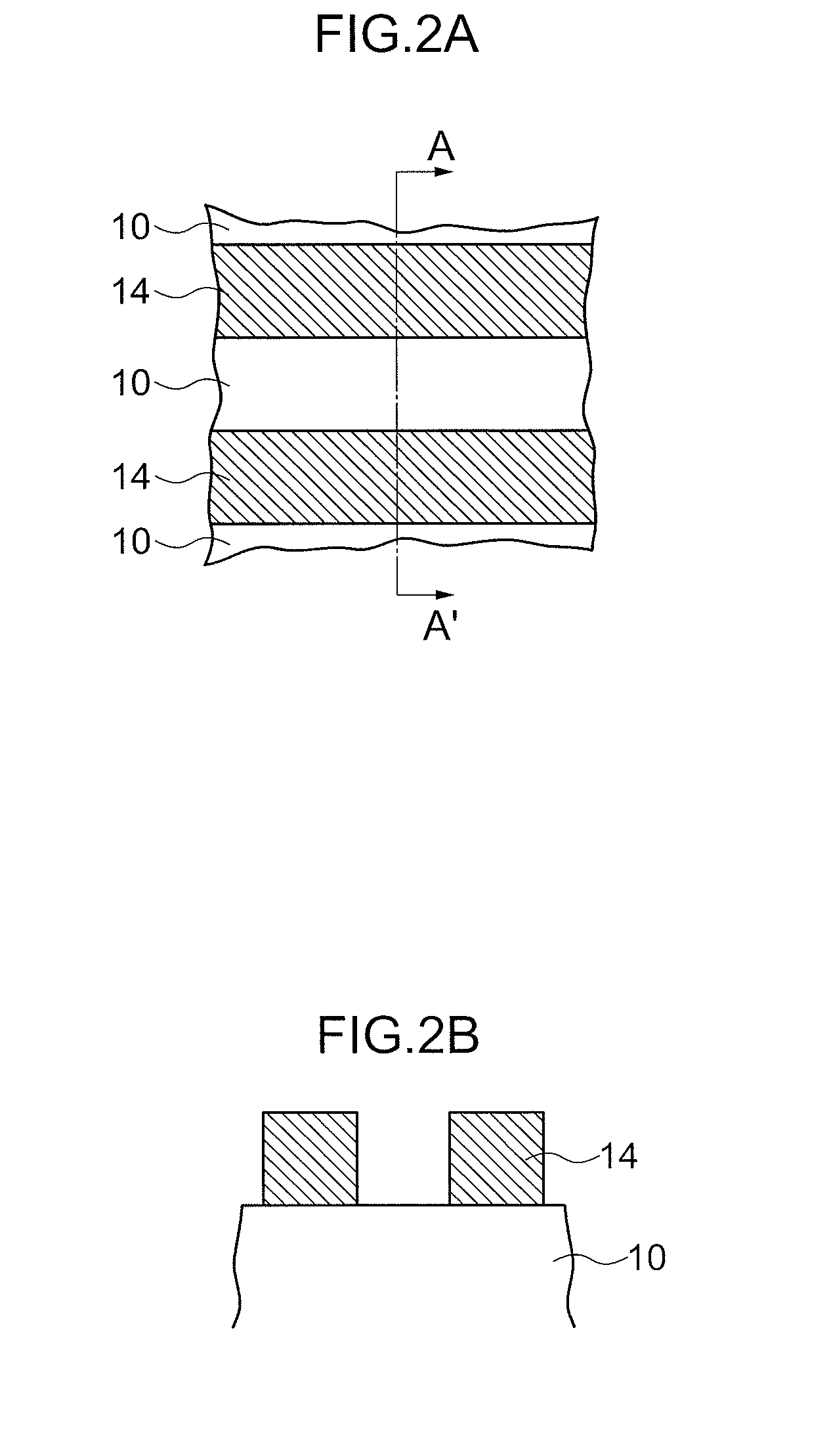Color filter, method for producing the same, and solid-state imaging device
a color filter and solid-state imaging technology, applied in the field of color filters, can solve the problems of conventional photolithographic methods reaching limitations in view of resolving power, film thickness, and inability to obtain desired film thickness in each color pixel, and achieve excellent rectangularity of color pixel, finer pattern, and improved pattern formation limitation
- Summary
- Abstract
- Description
- Claims
- Application Information
AI Technical Summary
Benefits of technology
Problems solved by technology
Method used
Image
Examples
first exemplary embodiment
[0194]The first exemplary embodiment is an exemplary embodiment of forming all of the first to the third color patterns by a photolithographic method. The first exemplary embodiment is hereinafter described while referring to FIGS. 1 to 8.
[0195]In FIGS. 1 to 8, A is a plan view and B is an A-A′ line cross-sectional view of A. In FIGS. 4 to 8, C is a B-B′ line cross-sectional view of A.
[0196](The First Color Pattern Forming Step)
[0197]First, as shown in FIG. 1, for example, a blue pattern material is applied on a support 10 to form a blue color layer 12 as a first color layer into a predetermined film thickness. Thereafter, pattern exposure, development and postbake treatment are performed to form a blue pattern 14, which is a striped pattern as shown in FIG. 2, as a first color pattern.
[0198]Then, in the case that a color filter array is designed as an assembly of square patterns, it is desirable that a pattern width of the blue pattern 14: an interval of the blue pattern 14 (that i...
second exemplary embodiment
[0215]The above-mentioned first and third color patterns may be formed by not merely a photolithographic method but also dry etching (including both the case of forming by the above-mentioned ‘dry etching method’ and the case of forming by the above-mentioned ‘etch back treatment’, and so forth).
[0216]The second exemplary embodiment of forming all of the first to the third color patterns by dry etching is hereinafter described while referring to FIGS. 9 to 18.
[0217]In FIGS. 9 to 18, A is a plan view and B is an A-A′ line cross-sectional view of A. In FIGS. 14 to 18, C is a B-B′ line cross-sectional view of A.
[0218]An exemplary embodiment of having a stopper layer is herein described.
[0219](The First Color Pattern Forming Step)
[0220]As shown in FIG. 9, for example, a red filter material is applied on a support 40 to form a red color layer 42 as a first color layer, and a stopper layer 44 is further formed on the formed red color layer 42 and subjected to baking treatment.
[0221]FIG. 9...
example 1
[0400]A color filter was produced in an exemplary embodiment of forming the first and the third color patterns by a photolithographic method (the first exemplary embodiment). The detailed producing method is hereinafter described.
[0401]
[0402]A blue (B) photocurable composition “trade name: SB-5000L” (manufactured by FUJIFILM Electronic Materials Co., Ltd.) was applied on a silicon substrate into an applied film with a thickness of 0.8 μm by a spin coater, and thereafter prebake treatment was performed at an applied film temperature or an atmospheric temperature of 100° C. for 2 minutes by using a hot plate to obtain a color layer B as a first color layer.
[0403]Subsequently, the color layer B was subjected to pattern exposure at an exposure amount of 200 mJ / cm2 by using an i-ray stepper (manufactured by Canon Inc.) and subjected to development treatment for 1 minute by using developer “trade name: CD-2060” (manufactured by FUJIFILM Electronic Materials Co., Ltd.), and thereafter subj...
PUM
| Property | Measurement | Unit |
|---|---|---|
| thickness | aaaaa | aaaaa |
| width | aaaaa | aaaaa |
| width | aaaaa | aaaaa |
Abstract
Description
Claims
Application Information
 Login to View More
Login to View More - R&D
- Intellectual Property
- Life Sciences
- Materials
- Tech Scout
- Unparalleled Data Quality
- Higher Quality Content
- 60% Fewer Hallucinations
Browse by: Latest US Patents, China's latest patents, Technical Efficacy Thesaurus, Application Domain, Technology Topic, Popular Technical Reports.
© 2025 PatSnap. All rights reserved.Legal|Privacy policy|Modern Slavery Act Transparency Statement|Sitemap|About US| Contact US: help@patsnap.com



